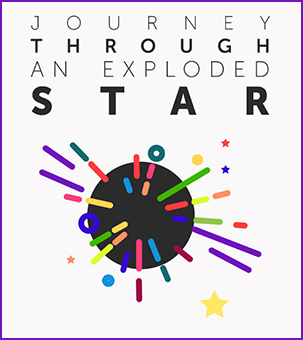"Journey Through an Exploded Star" Opens
A new way to interact and explore Cassiopeia A, the remains of an exploded star, has launched. The press release below outlines this novel initiative between the Smithsonian Center for Learning and Digital Access and the Chandra X-ray Center. Led by Chandra’s Kimberly Arcand, this project allows you to watch, interact, or learn about this supernova remnant while delving into astrophysics, computer science, and more.
This online interactive version of Cas A (as it’s referred to) is one latest milestone with Chandra. Cas A was the “First Light” image that Chandra observed just weeks after being launched into space in 1999. In the nearly twenty years since, Chandra has repeatedly observed Cas A, revealing new secrets about this object from the neutron star at its center to the elements of life it has expelled.
A decade ago, a team of scientists and image processors came together and created the first-ever three-dimensional model of Cas A. Now, this 3D model enters a new phase with the launching of "Journey Through an Exploded Star"” We hope you will explore with us.
Smithsonian Press Release:
Smithsonian Launches “Journey through an Exploded Star” 3D Interactive Experience
The Smithsonian today made available a new online interactive that allows users to explore a three-dimensional (3D) visualization of the remnants of a supernova, or exploded star.
Designed for use by both general audiences and high school science classrooms, the free materials, available at https://s.si.edu/supernova, include an interactive simulation, a 360° video, and a multimedia instructional package.
The project was created by the Smithsonian Center for Learning and Digital Access in conjunction with the Center for Astrophysics | Harvard & Smithsonian (CfA), a collaboration that includes the Smithsonian Astrophysical Observatory (SAO).
To create the visualizations, the project uses data from the Chandra X-ray Observatory and Spitzer Space Telescope, the National Optical Astronomy Observatory's Mayall Telescope, and the MIT/Michigan/Dartmouth Observatory’s Hiltner Telescope.
“Journey” features the data visualization work of Kimberly Arcand, visualization and emerging technology lead for Chandra, which is operated on behalf of NASA by SAO.
“All of that data has to be translated and processed in a way that humans can see, so it’s really important to be able to study our Universe using different kinds of light” said Arcand. “Each band of light gives you different information, so it’s like adding puzzle pieces to fit into the greater whole.”
“Journey through an Exploded Star” offers three ways to explore content:
- An online interactive simulation in which users navigate the fiery remains of a supernova and manipulate the real data to make their own visualization of the cosmos. (Closed Captioned, works across desktop browsers, and requires no software downloads.)
- A 360° video tour, narrated by Arcand, explains how and why scientists study supernovas such as Cassiopeia A to gain a comprehensive picture of these cosmic explosions. (Works on desktop, mobile, and Google Cardboard devices.)
- A high school classroom multimedia instructional package begins with the fundamentals of the electromagnetic spectrum and illustrates the production of elements from the explosions of stars. (Aligned to Next Generation Science Standards (HS-ESS1-3 and HS-PS4).)
The director of the Smithsonian Center for Learning and Digital Access, Stephanie L. Norby, said, “Projects such as this one make science learning both exciting and relevant for students. Using media tools, they can make a personal connection to topics that may initially seem esoteric to discover that there are forces that connect everyone to the stars.”
The Smithsonian Center for Learning and Digital Access makes all of this content freely available in its Smithsonian Learning Lab.
About the Smithsonian Center for Learning and Digital Access
The Smithsonian established the Smithsonian Center for Learning and Digital Access in 1976 to serve public education by bringing Smithsonian collections and expertise into the nation’s classrooms. For more than 40 years, it has published educational materials and provided one access point to Smithsonian educational resources. To understand the needs of teachers, students, and museum educators, the Center spent more than a decade in active experimentation and research, culminating in the launch of a new online platform — the Smithsonian Learning Lab. Since its launch in 2016, museum and classroom educators have used the Lab’s tools to create thousands of new examples — ranging from experiments to models — for using Smithsonian resources for learning. The Center now studies how teachers and students use digital museum resources and broadly disseminates this knowledge through professional development to advance museum and digital learning.
About the Center for Astrophysics | Harvard & Smithsonian
Headquartered in Cambridge, Mass., the Center for Astrophysics | Harvard & Smithsonian (CfA) is a collaboration between the Smithsonian Astrophysical Observatory and the Harvard College Observatory. CfA scientists, organized into six research divisions, study the origin, evolution and ultimate fate of the universe.
About the Chandra X-ray Observatory:
NASA's Marshall Space Flight Center in Huntsville, Alabama, manages the Chandra program for NASA's Science Mission Directorate in Washington. The Smithsonian Astrophysical Observatory in Cambridge, Massachusetts, controls Chandra's science and flight operations.
Contacts:
Darren Milligan
Smithsonian Center for Learning and Digital Access, Washington, DC
(202) 633-5291
milligand@si.edu
Megan Watzke
Chandra X-ray Center, Cambridge, Mass.
(617) 496-7998
mwatzke@cfa.harvard.edu
Tyler Jump
Center for Astrophysics | Harvard & Smithsonian
(917) 816-4001
tyler.jump@cfa.harvard.edu
Category:
- Log in to post comments

